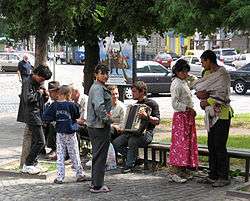Romani people in Ukraine
The presence of a Romani minority in Ukraine was first documented in the early 14th century. Romani maintained their social organizations and folkways, shunning non-Romani contacts, education and values, often as a reaction to anti-Romani attitudes and persecution. They adopted the language and faith of the dominant society being Orthodox in most of Ukraine, Catholic in Western Ukraine and Transcarpathia, and Islam in Crimea.

Demographics
- Census 1887: 12,000 Romani in Russian Ukraine (without Galicia and Transcarpathia who comprise the highest Ukrainian Romani population)
- Census 1922: 60,000 Romani in Ukrainian SSR (without Galicia and Transcarpathia)
- Census 1959: 28,000 Romani in Ukrainian SSR
- Census 1970: 30,100 Romani in Ukrainian SSR.
- Census 1979: 34,500 Romani in Ukrainian SSR
- Census 2001: 47,600 Romani in Ukraine. The estimate of the World Romani Union and the Council of Europe is considerably higher (around 400,000). The Romani organizations estimate the number at over 400,000 persons.[1]
Romani are scattered throughout Ukraine, but their largest concentration is in Transcarpathia. Half live in cities. 35% consider Romani their mother tongue. Material culture has not differed from the dominant society except in dress. They have a rich folk tradition. Romani themes can be found in Ukrainian literature.
The term Rom/Roma (Ukrainian: Ромá) is not generally used, accepted or understood in Ukraine, even by the Romani themselves. They are referred to by the generic term "Tsyhany" (Ukrainian: Цигaни)
- The Romani minority in Transcarpathia (census 2001)
Sub-groups
- Krimi (Крими), or Crimean intermingled with Crimean Tatars. The majority professes Islam. Further sub-groups include Audzhi (аюджі), Gurbety (гурбети), Mukani and others. During World War II Nazis killed 800 Crymy Roma in Simferopol. Stalin evicted Tatars and Romani to Central Asia in 1944.
- Gurbeti: The gypsy communities in Crimea in the 19th century were divided by "locals" and "chingene".[2] The Gurbeti (sometimes called Turkmen), lived mainly in the towns and steppe regions.[2] They traded horses and products made out of horse meat (such as the popular chir-chir-byurek).[2] The Krimurja in Crimea incorporated small numbers of Gurbeti through marriage, although in the 19th century they are listed as a separate group of "locals".[3] Their small number likely prevented them from an own community.[3] Their Romani language and nomadic lifestyle determined their separation to the Daifa, and their joining to the Krimurja.[3] In spite of intermarriage between the Gurbeti and Krimurja, a distinct origin is remembered, and an internal separation to some extent has been preserved.[3] In modern times, local Crimeans claim that the "chingene" deny their gypsy origin and declare as Crimean Tatars.[4]
See also
| Wikimedia Commons has media related to Romani people in Ukraine. |
| Part of a series on |
| Romani people |
|---|
|
Diaspora
|
|
References
- : In reality, by the preliminary estimates of communication within our nation, only the East of Ukraine has approximately 150 thousand Romani nationals, and we are sure that the Romani population on the territory of Ukraine reaches more than 400 thousand people.
- Geisenhaner-Lange, p. 427
- Geisenhaner-Lange,p. 437
- Geisenhaner-Lange, p. 432
Sources
- Encyclopedia of Ukraine Vol. 2 (G-K) Toronto, 1988
- УКРАЇНСЬКІ ЦИГАНИ